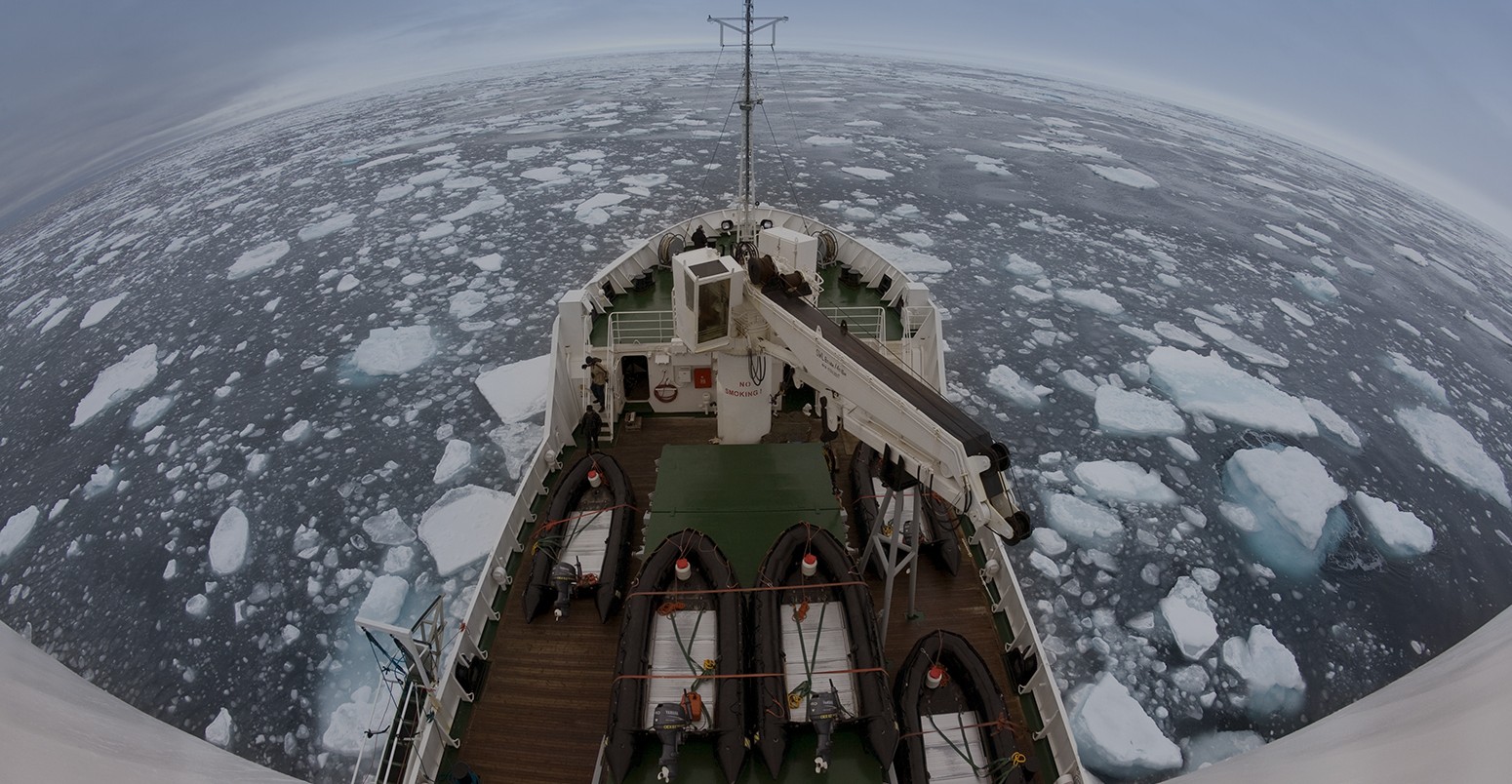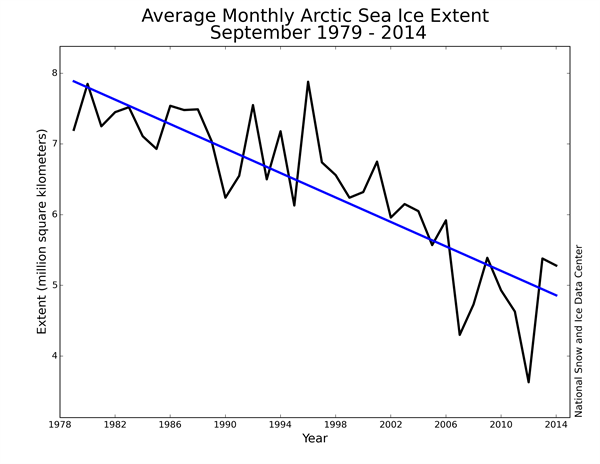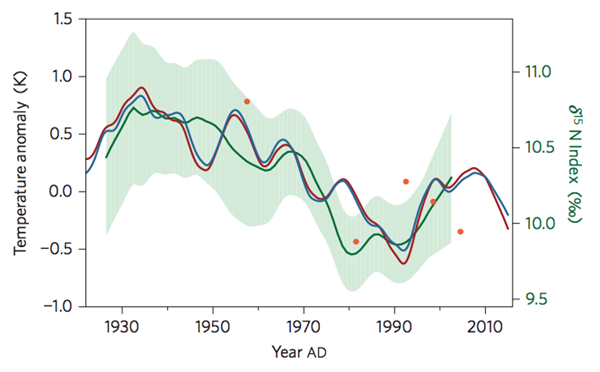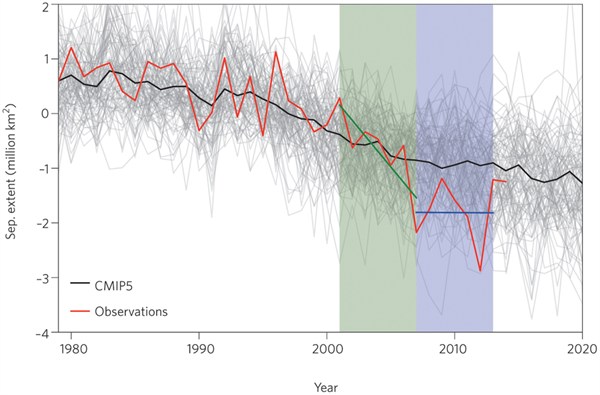
Natural variability could slow the pace of Arctic summer sea ice loss, study says
Robert McSweeney
03.30.15Robert McSweeney
30.03.2015 | 8:00pmNatural fluctuations in the oceans and atmosphere are currently conspiring to amplify the impact of manmade global warming on summer Arctic sea ice, according to a new paper.
Were these different cycles to weaken or reverse, they could instead dampen the warming effect in the Arctic, and slow the rate of Arctic sea ice loss, the author says.
But any change of pace would only be temporary, Dr Ed Hawkins, who leads an Arctic predictability project, tells Carbon Brief. We should expect the decline in sea ice to continue in the long-term, he says.
Declining summer sea ice
Scientists have been using satellites to measure Arctic sea ice since 1979. As one measure of the Arctic’s health, scientists record its smallest extent each year, which it usually hits at the end of summer. You can see the long-term decrease in September sea ice in the graph below, with the eight smallest summer extents all recorded in the last eight years.
Average September Arctic sea ice extent from full satellite record (1979-2014), Source: NSIDC
With Arctic temperatures rising twice as fast as the global average, scientists have linked the sea ice decline to human influences on the climate. Hawkins explains:
“The retreat of Arctic sea ice over the past 35 years has been dramatic, and is, at least partly, due to increases in greenhouse gas concentrations.”
But scientists also know that natural fluctuations are responsible for around half of the decrease. These natural fluctuations, such as wind and ocean circulation patterns, can bring warmer or colder conditions to the Arctic, either promoting or inhibiting the melting of ice.
A new study, published in Proceedings of the National Academy of Sciences, takes a closer look at these natural fluctuations. It says that at the moment they’re contributing to faster Arctic ice melt. But were they to weaken, it could put the brakes on Arctic summer sea ice decline.
Heat transport
Natural cycles can vary from one decade, or even century, to the next, lead author Dr Rong Zhang, an oceanographer from the Geophysical Fluid Dynamics Laboratory in the US, tells Carbon Brief.
This means just looking at the satellite record could miss some patterns of changes. Instead, Zhang uses a climate model to simulate 3,600 years of Arctic conditions to see how this variability plays out in the long term.
She found three different ways in which natural variability is affecting Arctic sea ice. The first two involve the amount of heat transported by Pacific and Atlantic Oceans. These oceans perpetually drag warm water from the equator towards the poles on giant conveyor belts, but the amount of heat they shift can vary naturally. The third way is related to wind patterns over the Arctic, which can drive sea ice out from the central Arctic.
Atlantic conveyor
All three natural patterns are currently contributing to the loss of summer Arctic sea ice, says Zhang.
However, although the study looks at natural changes, human influence on circulation patterns can also affect sea ice. A paper last week, for example, suggested the Atlantic conveyor could be slowing down over much longer timescales.
A weaker Atlantic conveyor would bring less heat to the Arctic, and possibly mean less melting of sea ice. And though its strength would still experience the ups and downs of natural variability, an overall downward trend could mean a slowing of sea ice loss.
You can see the weakening in the conveyor in the graph below. The researchers say it’s caused by melting of the Greenland ice sheet causing an influx of freshwater in the North Atlantic.
Observed changes in Atlantic Ocean circulation, using three different methods of estimating circulation changes. Source: Rahmstorf et al. ( 2015)
‘Quite conceivable’
So with three natural ways the climate can affect Arctic sea ice, on top of the influence of human-caused warming, it’s no surprise that Arctic sea ice varies so much from year to year.
Another recent paper, co-authored by Hawkins, highlighted the variability of summer sea ice decline. The study finds the extent of summer sea ice dropped off very quickly between 2001 and 2007, before a period of little change between 2007 and 2013. You can see this in the graph below, from the steep decline of the green line, to the flat blue line that follows it.
September Arctic sea ice extent, shown as a difference from the 1980-2000 average. Graph shows observations (red) and model output (grey) and model output (black). Shaded areas show short-term trend in observations over 2001-2007 (green) and 2007-2013 (blue). Source: Swart et al. ( 2015)
A slowdown in Arctic sea ice decline, or even a period where it stays steady, shouldn’t come as a surprise, says Hawkins:
“It is quite conceivable that a period of near-zero Arctic sea ice trend could last a decade or more due solely to climate variability masking the anthropogenically induced decline.”
Ice-free summer
With recent rates of decline, the Intergovernmental Panel on Climate Change estimates that Arctic summers could be ice-free before the middle of the century. ‘Ice-free’ is defined as less than one million square kilometers of sea ice for at least five summers in a row.
But the new study suggests it might take longer if natural fluctuations weaken, says Zhang:
“[There might be] a delay in attaining a summer ice-free Arctic if natural variability were to reverse in the near future.”
Equally, Zhang says it wouldn’t be realistic to try and predict an ice-free summer just on the basis current trends:
“Simply extrapolating the short observed record of Arctic sea ice loss would overestimate future changes.”
The chaotic nature of our climate system shows why predicting Arctic sea ice isn’t straightforward. And although we can expect to see ups and downs from one year or decade to the next, the decline is still set to continue in the long-term.
Zhang, R. 2015. Mechanisms for low-frequency variability of summer Arctic sea ice extent, Proceedings of the National Academy of Sciences, doi:10.1073/pnas.1422296112
-
Natural variability could slow the pace of Arctic summer sea ice loss, study says




